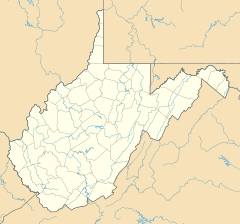Swiss, West Virginia facts for kids
Quick facts for kids
Swiss
|
|
|---|---|
| Country | United States |
| State | West Virginia |
| County | Nicholas |
| Time zone | UTC-5 (Eastern (EST)) |
| • Summer (DST) | UTC-4 (EDT) |
| ZIP code |
26731
|
| Area code(s) | 304 and 681 |
Swiss is a small place in western Nicholas County, West Virginia, United States. It's called an "unincorporated community" because it doesn't have its own local government. Swiss is about 735 feet (224 meters) above sea level.
You can find Swiss on the north side of the Gauley River. This river also forms the border with Fayette County. West Virginia Route 39 is the main road that goes through the community.
Contents
History of Swiss
Swiss is located along the Gauley River. It's about ten miles upstream from a place called Gauley Bridge. The Native Americans who lived here long ago called the Gauley River "Toki-biloki," which means "falling creek."
Early Settlers and Land
Around 1830, a man named James Simms settled near what is now Swiss. Later, in 1867, Henry Riggs sold 125 acres of land near Little Elk Creek to Franklin P. Simms. This land was passed down through the Simms family.
In 1890, Robert M. Hill sold 27.5 acres to John H. Kunz. This land was about a mile upriver from Little Elk Creek. George Kincaid also sold 27.5 acres next to Kunz's land in the same year. The Kunz family still owns this land today.
How Swiss Got Its Name
People in the community needed a new post office because the trip to the Belva Post Office was too long. They had to suggest three names, but only had two. John Kunz, who was an immigrant from Switzerland, joined the group. As a joke, they suggested "Swiss" because Kunz often used "Swiss" after his name. This helped people tell him apart from the Koontz family, who were German and also used the Belva Post Office.
The Post Office Department liked the name "Swiss" and chose it! Swiss got its name and its own post office around 1904 or 1908.
Timber and Railroads
Around 1903, the Flynn Lumber Company bought a huge amount of trees in the Swiss area. They built a large sawmill, a railroad, and a company store. This helped them cut down and move many trees. The sawmill and store were located near Little Elk Creek, close to the Gauley River. This was also where the Kanawha and West Virginia Railroad ended, connecting Swiss to Charleston. The company store also sold train tickets, handled freight, and served as the post office.
Later, around 1923, the Morgan Lumber Company used the Flynn Lumber Company's railroad and land to harvest more timber. Their smaller sawmill was also near the Flynn company store.
The New York Central Railroad eventually bought the Kanawha and West Virginia Railroad. They started offering passenger and freight services from Columbus, Ohio, all the way to Swiss. Some coal mines also started operating nearby. The Chesapeake and Ohio and New York Central Railroads later joined to create the Nicholas, Fayette, & Greenbrier Railroad (NF&G RR). This new line went from Swiss upriver through Fayette and Greenbrier Counties. It helped transport coal and timber from those areas to Swiss and beyond.
The Flynn Lumber Company store burned down between 1939 and 1941 and was not rebuilt. Walter Simms, who was the Postmaster then, built a small concrete building. This building, located near the intersection of Route 39 and River Road, became the new post office for many years.
Mills and Churches
The first mill for grinding grains like wheat and corn was at Kanawha Falls. Later, a Morris family member built a mill near what is now Beech Glen. In 1890, John H. Kunz built a water-powered mill on Laurel Creek, about two miles from Swiss. This mill burned down around 1910.
The first church in Nicholas County was built in 1824 near where the Simms Methodist Church is today. It was a meeting place for all kinds of people and religious groups. People would travel many miles to worship there. This first church burned down before the Civil War.
In 1867, another meeting house was built near the school on Little Elk Creek, but it also burned. Later, a community hall was built near the railroad station and school. This hall was used for all community events and religious services by different groups like Baptists and Methodists. In 1922, Moletist Simms donated land for a new Methodist Church. This new church, which could seat 300 people, opened in 1923 and is still active today. A basement was added in 1928.
Naming Little Elk Creek
Little Elk Creek, which flows through Swiss, was named by James Simms. Some of his friends lived on Elk River and wanted him to move closer to them. Simms replied, "There's a creek near me with lots of beautiful redbud flowers. I'll just call it Little Elk, and then I won't need to move!"



